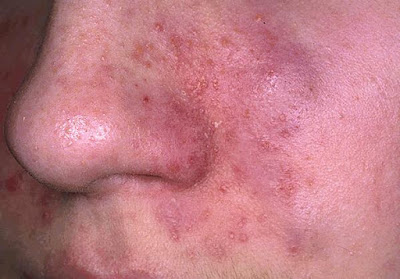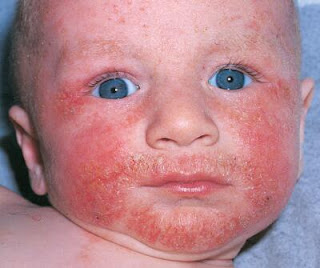Atopic dermatitis(eczema ) is an immune-mediated inflammation of the skin, often with
a significant genetic component. Pruritus is the primary symptom; skin lesions
range from mild erythema to severe lichenification. Diagnosis is by history and
examination. Treatment is moisturizers, avoidance of allergic and irritant
triggers, and often topical corticosteroids.
1. All eczema is commonly due to allergies and dry skin combined.
2. All alergies has resistance levels. This means if you give a product today and it was OK then that does not mean that person is not allergetic to it. Tomorow the same product can trigger allergies.
3. Protiens are the source of major allergies. Try to introduce protien rich food later. Also avoid milk, potatoes, wheat, eggs (esp. whites), sea-food, food colors, artificial food favorings and nuts. (Try goat's milk instead of cow's milk)
4. Keep the child away if you are cooking in your home. I found that the smell of allergy causing food also creates allergies.
5. Keep a log of daily activities including food / drinks, motion and irritations. If you keep the log it will be easier to find the problem foods.
6. Give one food for one week without switching. Start with rice and carrots or rice and broccoli (choose one). Give the same food for a week. If severe allergies are noted then remove it from diet and introduce a new one. Any one food introduced should be given continously for 1 week.
7. After giving a bath pat with a towel slightly leaving a film of water in the skin. Seal that to skin by applying thick gel like plain Vaseline. Many creams also create allergies so be careful in using creams other than plain unscented Vaseline. Also do not use the baby oil - many kids are allergic to mineral oil.
8. The allergies becomes severe if you reintroduce the same allergic food again and again but may go away if you remove it from diet for long periods like more than a month.
9. Angry and sad moods of child make the situation worse. I know that a child with eczema takes parents to the edge and many times we may become harsh. Try to keep your child happy.
10. An unconventional treatment, NAET worked well for my grandson. For people I have referred it did not work well since it depends a lot on the practitioner. For my granddaughter we did not take treatment since we knew a lot about eczema and could control it well.
11. It is late to tell you but it is best to introduce the solids a little late to kids with eczema.
12. If your child has severe itch, ask him/her to scratch using the back of the nails by scratching backwards (in the opposite direction of normal scratch). You can also scratch him like that. Less damage occurs by scratching reverse.
Please see the web pages for more details on Eczema (Atopic dermatitis).
1. All eczema is commonly due to allergies and dry skin combined.
2. All alergies has resistance levels. This means if you give a product today and it was OK then that does not mean that person is not allergetic to it. Tomorow the same product can trigger allergies.
3. Protiens are the source of major allergies. Try to introduce protien rich food later. Also avoid milk, potatoes, wheat, eggs (esp. whites), sea-food, food colors, artificial food favorings and nuts. (Try goat's milk instead of cow's milk)
4. Keep the child away if you are cooking in your home. I found that the smell of allergy causing food also creates allergies.
5. Keep a log of daily activities including food / drinks, motion and irritations. If you keep the log it will be easier to find the problem foods.
6. Give one food for one week without switching. Start with rice and carrots or rice and broccoli (choose one). Give the same food for a week. If severe allergies are noted then remove it from diet and introduce a new one. Any one food introduced should be given continously for 1 week.
7. After giving a bath pat with a towel slightly leaving a film of water in the skin. Seal that to skin by applying thick gel like plain Vaseline. Many creams also create allergies so be careful in using creams other than plain unscented Vaseline. Also do not use the baby oil - many kids are allergic to mineral oil.
8. The allergies becomes severe if you reintroduce the same allergic food again and again but may go away if you remove it from diet for long periods like more than a month.
9. Angry and sad moods of child make the situation worse. I know that a child with eczema takes parents to the edge and many times we may become harsh. Try to keep your child happy.
10. An unconventional treatment, NAET worked well for my grandson. For people I have referred it did not work well since it depends a lot on the practitioner. For my granddaughter we did not take treatment since we knew a lot about eczema and could control it well.
11. It is late to tell you but it is best to introduce the solids a little late to kids with eczema.
12. If your child has severe itch, ask him/her to scratch using the back of the nails by scratching backwards (in the opposite direction of normal scratch). You can also scratch him like that. Less damage occurs by scratching reverse.
Please see the web pages for more details on Eczema (Atopic dermatitis).


